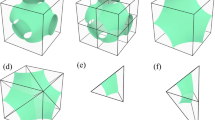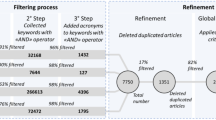Abstract
The concurrent design of materials and products provides designers with flexibility to achieve design objectives that were not previously accessible. However, the improved flexibility comes at a cost of increased complexity of the design process chains and the materials simulation models used for executing the design chains. Efforts to reduce the complexity generally result in increased uncertainty. We contend that a systems based approach is essential for managing both the complexity and the uncertainty in design process chains and simulation models in concurrent material and product design. Our approach is based on simplifying the design process chains systematically such that the resulting uncertainty does not significantly affect the overall system performance. Similarly, instead of striving for accurate models for multiscale systems (that are inherently complex), we rely on making design decisions that are robust to uncertainties in the models. Accordingly, we pursue hierarchical modeling in the context of design of multiscale systems. In this paper our focus is on design process chains. We present a systems based approach, premised on the assumption that complex systems can be designed efficiently by managing the complexity of design process chains. The approach relies on (a) the use of reusable interaction patterns to model design process chains, and (b) consideration of design process decisions using value-of-information based metrics. The approach is illustrated using a Multifunctional Energetic Structural Material (MESM) design example. Energetic materials store considerable energy which can be released through shock-induced detonation; conventionally, they are not engineered for strength properties. The design objectives for the MESM in this paper include both sufficient strength and energy release characteristics. The design is carried out by using models at different length and time scales that simulate different aspects of the system. Finally, by applying the method to the MESM design problem, we show that the integrated design of materials and products can be carried out more efficiently by explicitly accounting for design process decisions with the hierarchy of models.
Similar content being viewed by others
Abbreviations
- U min :
-
Lower bound on expected utility
- U max :
-
Upper bound on expected utility
- α :
-
Coefficient of pessimism, measuring decision maker’s aversion to risk
- P I :
-
Improvement potential
- (U min)* :
-
Lower bound on expected payoff at decision point
- (U max)* :
-
Upper bound on expected payoff at decision point
- U i :
-
Utility of ith design goal
- \({d_{i}^{-}}\) :
-
Underachievement of utility compared to the target value of 1
- \({d_{i}^{+}}\) :
-
Overachievement of utility compared to the target value
- k i :
-
Weight assigned to the ith goal
- accFe:
-
Accumulated mass fraction of Iron
- SizeAl:
-
Size of aluminum particles
- SizeFe2O3 :
-
Size of iron oxide particles
- SizeVoids:
-
Size of voids
- VF voids:
-
Volume fraction of voids
- RadFilling:
-
Amount of MESM stored in the container
References
Olson, G.B.: Computational design of hierarchically structuredmaterials. Science 277, 1237–1242 (1997)
Ashby, M.F.: Materials Selection in Mechanical Design. Butterworth-Heinemann, Oxford (1999)
Panchal, J.H., Choi, H.-J., Shephard, J., Allen, J.K., McDowell, D.L., Mistree, F.: A strategy for simulation-based multiscale, multifunctional design of products and design processes. In: Proceedings of ASME Design Automation Conference, Long Beach, CA (2005)
Choi, H.-J., Allen, J.K., Rosen, D., McDowell, D.L., Mistree, F.: An inductive design exploration method for the integrated design of multi-scale materials and products. In: Proceedings of Design Automation Conference, Long Beach (2005)
Choi, H.-J., Austin, R., Allen, J.K., McDowell, D.L., Mistree, F.: An approach for robust micro-scale materials design under unparameterizable variability. In: Proceedings of 10th AIAA/ISSMO Multidisciplinary Analysis and Optimization Conference, Albany, NY (2004)
Choi, H.-J., Austin, R., Allen, J.K., McDowell, D.L., Mistree, F.: An approach for robust design of reactive powder metal mixtures based on non-deterministic micro-scale shock simulation. J. Comput. Aided Mater. Des. 12(1), 57–85 (2005)
Simpson, T.W., Rosen, D., Allen, J.K., Mistree, F.: Metrics for assessing design freedom and information certainty in the early stages of design. J. Mech. Des. 120(4), 628–635 (1998)
Wood, W.H.: Quantifying design freedom in decision based conceptual design. In: Proceedings of ASME Design Engineering Technical Conferences, Baltimore, Maryland (2000)
Taguchi, G.: Introduction to Quality Engineering. UNIPUB, New York (1986)
Mistree, F., Seepersad, C.C., Dempsey, B.M., McDowell, D.L.: Robust concept exploration methods in materials design. In: Proceedings of 9th AIAA/ISSMO Symposium on Multidisciplinary Analysis and Optimization, Atlanta, GA (2002)
Chen, W.: A robust concept exploration method for configuring complex systems. Ph.D. Dissertation, Georgia Institute of Technology, Atlanta, GA (1995)
Choi, H.-J.: A robust design method for model and propagated uncertainty. Ph.D. Dissertation, Georgia Institute of Technology, Atlanta (2005)
Box, G.E.P.: Robustness in the strategy of scientific model building. In: Launer, R.L., Wilkinson, G.N.(eds) Robustness in Statistics, pp. 201–235. Academic Press, New York (1979)
Lawrence, D.B.: The Economic Value of Information. Springer, New York (1999)
Howard, R.: Information value theory. IEEE Trans. Syst. Sci. Cybern. SSC-2(1), 779–783 (1966)
Poh, K.L., Horvitz, E.: Reasoning about the value of decision model refinement: methods and application. In: Proceedings of Ninth Conference on Uncertainty in Artificial Intelligence, Washington DC, July (1993)
Aughenbaugh, J.M., Ling, J.M., Paredis, C.J.J.: The use of imprecise probabilities to estimate the value of information in design. In: Proceedings of ASME International Mechanical Engineering Congress and Exposition, Orlando, FL, USA, 5–11 November (2005)
Arrow, K., Hurwicz, L.: An optimality criterion for decision-making under ignorance. In: Carter, C.F., Ford, J.L.(eds) Uncertainty and Expectation in Economics: Essays in Honour of G.L. S. Shackle, Blackwell, Oxford (1972)
Seepersad, C.C.: The utility-based compromise decision support problem with applications in product platform design. MS Thesis, Georgia Institute of Technology, Atlanta, GA (2001)
Mistree, F., Hughes, O.F., Bras, B.A.: The compromise decision support problem and the adaptive linear programming algorithm. In: Kamat, M.P.(eds) Structural Optimization: Status and Promise, pp. 247–286. AIAA, Washington (1993)
Austin, R.A., McDowell, D.L., Benson, D.J.: Numerical simulation of shock wave propagation in spatially-resolved microscale particle systems. Model. Simulat. Mater. Sci. Eng. 14, 537–561 (2006)
Austin, R.A.: Numerical simulation of the shock compaction of microscale reactive particle systems. MS Thesis, Georgia Institute of Technology, Atlanta (2005)
Benson, D.J.: A multi-material eulerian formulation for the efficient solution of impact and penetration problems. Comput. Mech. 15, 558–571 (1995)
Choi, H.-J., Austin, R., Allen, J.K., McDowell, D.L., Mistree, F., Benson, D.J.: An approach for robust design of reactive powder metal mixtures based on non-deterministic micro-scale shock simulation. J. Comput. Aided Mater. Des. 12(1), 57–85 (2005)
Lu, X., Narayanan, V., Hanagud, S.: Shock induced chemical reactions in energetic structural materials. In: Proceedings of 13th American Physical Society Topical Conference on Shock Compression of Condensed Matter, Portland, Oregon, 20–25 July (2003)
Taylor, G.I.: The testing of materials at high rates of loading. J. Inst. Civil Eng. 26, 486–519 (1946)
Taylor, G.I.: The use of flat ended projectiles for determining yield stress. I: theoretical consideration. Proc. R. Soc. Lond. A194, 289–299 (1948)
Patel, N.: Intermediate Strain Rate Behavior of Two Structural Energetic Materials. Georgia Institute of Technology, Atlanta (2004)
Merzhanov, A.G.: On critical conditions for thermal explosion of a hot spot. Combust. Flame 10, 341–348 (1966)
Panchal, J.H.: A framework for simulation-based integrated design of multiscale products and design processes. Ph.D. Dissertation, Georgia Institute of Technology, Atlanta (2005)
Author information
Authors and Affiliations
Corresponding author
Rights and permissions
About this article
Cite this article
Panchal, J.H., Choi, HJ., Allen, J.K. et al. A systems-based approach for integrated design of materials, products and design process chains. J Computer-Aided Mater Des 14 (Suppl 1), 265–293 (2007). https://doi.org/10.1007/s10820-007-9062-0
Received:
Revised:
Accepted:
Published:
Issue Date:
DOI: https://doi.org/10.1007/s10820-007-9062-0




